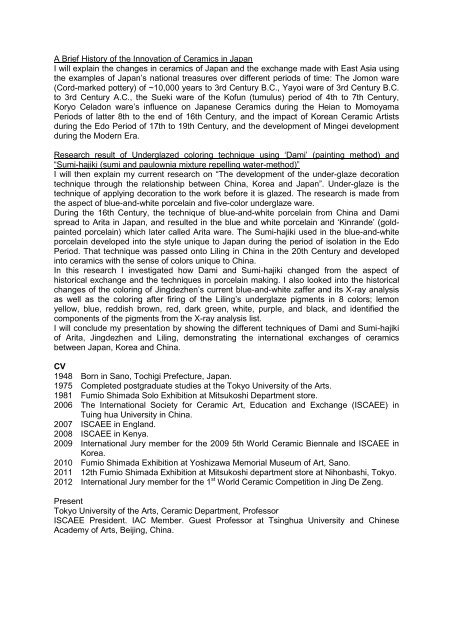Fumio Shimada National University of Fine Arts and Music Ceramic ...
Fumio Shimada National University of Fine Arts and Music Ceramic ...
Fumio Shimada National University of Fine Arts and Music Ceramic ...
You also want an ePaper? Increase the reach of your titles
YUMPU automatically turns print PDFs into web optimized ePapers that Google loves.
A Brief History <strong>of</strong> the Innovation <strong>of</strong> <strong>Ceramic</strong>s in Japan<br />
I will explain the changes in ceramics <strong>of</strong> Japan <strong>and</strong> the exchange made with East Asia using<br />
the examples <strong>of</strong> Japan’s national treasures over different periods <strong>of</strong> time: The Jomon ware<br />
(Cord-marked pottery) <strong>of</strong> ~10,000 years to 3rd Century B.C., Yayoi ware <strong>of</strong> 3rd Century B.C.<br />
to 3rd Century A.C., the Sueki ware <strong>of</strong> the K<strong>of</strong>un (tumulus) period <strong>of</strong> 4th to 7th Century,<br />
Koryo Celadon ware’s influence on Japanese <strong>Ceramic</strong>s during the Heian to Momoyama<br />
Periods <strong>of</strong> latter 8th to the end <strong>of</strong> 16th Century, <strong>and</strong> the impact <strong>of</strong> Korean <strong>Ceramic</strong> Artists<br />
during the Edo Period <strong>of</strong> 17th to 19th Century, <strong>and</strong> the development <strong>of</strong> Mingei development<br />
during the Modern Era.<br />
Research result <strong>of</strong> Underglazed coloring technique using ‘Dami’ (painting method) <strong>and</strong><br />
“Sumi-hajiki (sumi <strong>and</strong> paulownia mixture repelling water-method)”<br />
I will then explain my current research on “The development <strong>of</strong> the under-glaze decoration<br />
technique through the relationship between China, Korea <strong>and</strong> Japan”. Under-glaze is the<br />
technique <strong>of</strong> applying decoration to the work before it is glazed. The research is made from<br />
the aspect <strong>of</strong> blue-<strong>and</strong>-white porcelain <strong>and</strong> five-color underglaze ware.<br />
During the 16th Century, the technique <strong>of</strong> blue-<strong>and</strong>-white porcelain from China <strong>and</strong> Dami<br />
spread to Arita in Japan, <strong>and</strong> resulted in the blue <strong>and</strong> white porcelain <strong>and</strong> ‘Kinr<strong>and</strong>e’ (goldpainted<br />
porcelain) which later called Arita ware. The Sumi-hajiki used in the blue-<strong>and</strong>-white<br />
porcelain developed into the style unique to Japan during the period <strong>of</strong> isolation in the Edo<br />
Period. That technique was passed onto Liling in China in the 20th Century <strong>and</strong> developed<br />
into ceramics with the sense <strong>of</strong> colors unique to China.<br />
In this research I investigated how Dami <strong>and</strong> Sumi-hajiki changed from the aspect <strong>of</strong><br />
historical exchange <strong>and</strong> the techniques in porcelain making. I also looked into the historical<br />
changes <strong>of</strong> the coloring <strong>of</strong> Jingdezhen’s current blue-<strong>and</strong>-white zaffer <strong>and</strong> its X-ray analysis<br />
as well as the coloring after firing <strong>of</strong> the Liling’s underglaze pigments in 8 colors; lemon<br />
yellow, blue, reddish brown, red, dark green, white, purple, <strong>and</strong> black, <strong>and</strong> identified the<br />
components <strong>of</strong> the pigments from the X-ray analysis list.<br />
I will conclude my presentation by showing the different techniques <strong>of</strong> Dami <strong>and</strong> Sumi-hajiki<br />
<strong>of</strong> Arita, Jingdezhen <strong>and</strong> Liling, demonstrating the international exchanges <strong>of</strong> ceramics<br />
between Japan, Korea <strong>and</strong> China.<br />
CV<br />
1948 Born in Sano, Tochigi Prefecture, Japan.<br />
1975 Completed postgraduate studies at the Tokyo <strong>University</strong> <strong>of</strong> the <strong>Arts</strong>.<br />
1981 <strong>Fumio</strong> <strong>Shimada</strong> Solo Exhibition at Mitsukoshi Department store.<br />
2006 The International Society for <strong>Ceramic</strong> Art, Education <strong>and</strong> Exchange (ISCAEE) in<br />
Tuing hua <strong>University</strong> in China.<br />
2007 ISCAEE in Engl<strong>and</strong>.<br />
2008 ISCAEE in Kenya.<br />
2009 International Jury member for the 2009 5th World <strong>Ceramic</strong> Biennale <strong>and</strong> ISCAEE in<br />
Korea.<br />
2010 <strong>Fumio</strong> <strong>Shimada</strong> Exhibition at Yoshizawa Memorial Museum <strong>of</strong> Art, Sano.<br />
2011 12th <strong>Fumio</strong> <strong>Shimada</strong> Exhibition at Mitsukoshi department store at Nihonbashi, Tokyo.<br />
2012 International Jury member for the 1 st World <strong>Ceramic</strong> Competition in Jing De Zeng.<br />
Present<br />
Tokyo <strong>University</strong> <strong>of</strong> the <strong>Arts</strong>, <strong>Ceramic</strong> Department, Pr<strong>of</strong>essor<br />
ISCAEE President. IAC Member. Guest Pr<strong>of</strong>essor at Tsinghua <strong>University</strong> <strong>and</strong> Chinese<br />
Academy <strong>of</strong> <strong>Arts</strong>, Beijing, China.



